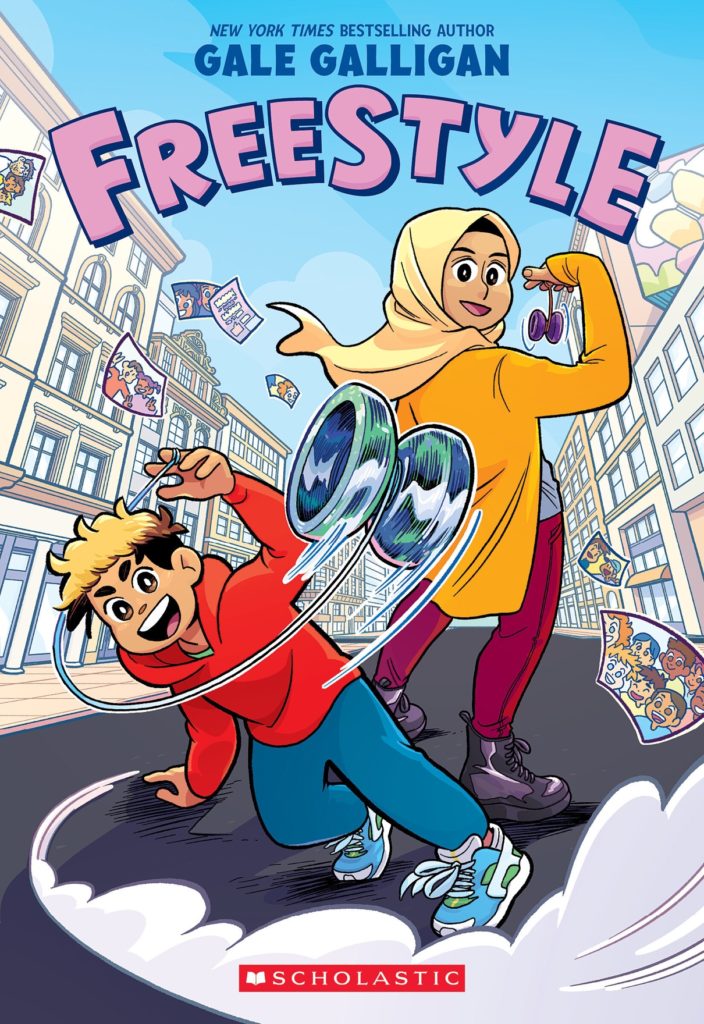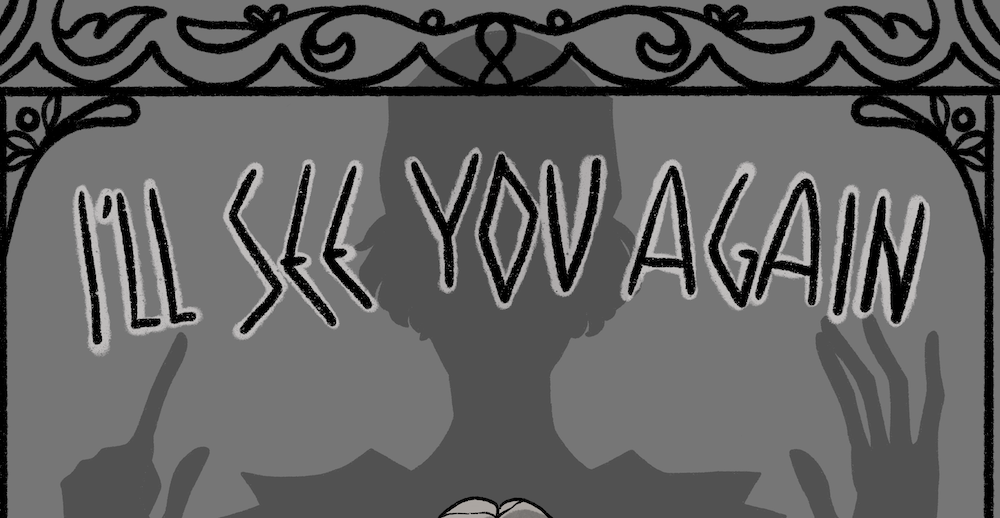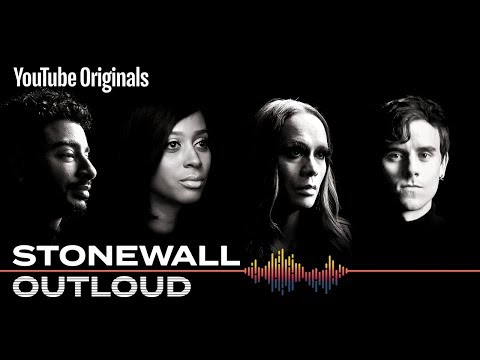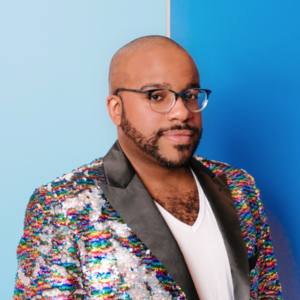Gale Galligan is the creator of the New York Times bestselling Baby-sitters Club graphic novel adaptations of Dawn and the Impossible Three, Kristy’s Big Day, Boy-Crazy Stacey, and Logan Likes Mary Anne! by Ann M. Martin. They are also the creator of Freestyle, an original graphic novel that they both wrote and illustrated. Gale was featured in The Claudia Kishi Club, a documentary now streaming on Netflix. When they aren’t making comics, Gale enjoys knitting, reading, and spending time with their family and adorable pet rabbits. They live in Pearl River, New York.
I had the opportunity to interview Gale which you can read below.
First of all, welcome to Geeks OUT! Could you tell us a little about yourself?
Thank you for having me! I’m a graphic novelist named Gale Galligan. I love comics, shrimp chips, and animals. My family adopted a kitten recently, qualifying us for actual menagerie status. The count is now: two rabbits, one elderly leopard gecko, several fish, a toddler, and the aforementioned cat. They’re all very fun to draw.
What inspired you to get into comics, particularly those for younger readers? Were there any writers or stories that sparked your own love and interest in storytelling?
There’s something so special about the stories you can get your hands on as a kid. You read them over and over again and they lodge themselves deep into your brain as a sense memory. Sometimes, they seem so accessible that you can’t help but try to make one for yourself.
What I’m saying is, I was really into Garfield growing up.
I started off drawing my own comics inspired by that, as well as other favorites like Calvin and Hobbes and The Far Side. My favorite part was sharing them with people and seeing their reactions. As I grew older, I kept finding new stories to fall in love with. I was especially into Animorphs, the Chrestomanci quartet by Diana Wynne Jones, and all of the anime I could get my hands on in the early 2000s.
And I kept drawing the whole time! I drew comics about things that were going on in my life. I drew collaborative stories with my friends. I made a lot of fan comics and posted them online. Comics really were a way for me to connect with people and share big feelings with them, and I think that’s still what drives me today.
As an artist, who or what would you say are some of your greatest creative influences and/or sources of inspiration?
I could go on forever but will respect your server space. Here’s a brief list of things I keep coming back to:
The works of Fumi Yoshinaga, particularly What Did You Eat Yesterday? and Flower of Life (sadly long out-of-print). Her storytelling style is so special – it’s gentle, bittersweet, and funny, and her characters always grow so naturally. It seems effortless when she does it. Ugh!!
Everything by Jen Wang. The acting, the panel work, the flow… the feelings! When I’m feeling stuck with my own work, one of the first things I do is pull out Prince and the Dressmaker. “Oh, I want to make comics! Let’s go!!”
My friendsssss. I’m very blessed to know so many incredible people. They’re excited about a billion different things and have all kinds of amazing talents. It’s hard not to come away feeling inspired about something.
What can you tell us about your upcoming book, Freestyle? What inspired this story?
Freestyle is about an eighth-grade b-boy named Cory Tan who’s been with his dance crew – his best friends – for years. They’re trying to win a big competition together before high school, but their captain is being really controlling and bringing everyone down. When he develops a newfound passion for yo-yo, he starts spending less time with his crew and more with his tutor-slash-friend-slash-yo-yo-mentor, Sunna. Will things come to a breaking point right around the end of the second act? You bet!!
There are a lot of big feelings (my jam), as well as yo-yo, b-boying, and the most gorgeous colors from K Czap. Please look at the book so you can compliment K’s colors, if nothing else.
As for where it came from… there were a few things I knew I wanted to do. I wanted to tell a story about young people navigating all kinds of expectations. I wanted to make something really, really fun and goofy and kinetic. And I wanted to take inspiration from things that bring me joy. Sports anime. Dance movies. The really special feeling of getting really into something and finding people to share that with. Yo-yo really pulls all of that together, and I am saying this very sincerely. It is such an incredible, personal form of expression. People are coming up with their own routines, inventing their own tricks, sharing with their communities – it’s really cool. I absolutely love watching people throw but am still not very good myself, so I’m living vicariously through drawings.
For those curious about the process behind a graphic novel, how would you describe the process? What goes into creating a script and translating that into panels?
The great thing is, there’s no one way to make a graphic novel. You could ask five different people and get five different answers. So here’s mine!
- Outline. Once I’ve pulled ideas from the ether, I write them out. The outline is like a short essay about the story I want to make, beginning to end, nothing fancy. Then I take it to my friends, writing group, and editor, get great feedback, return to my cave, and revise until I get something I like (hopefully).
- Script. Some people draw their scripts right off the bat. I write mine with words first, just because that’s how my brain happens to organize itself. My script is broken down into pages and panels, and since I’m the one who will also be drawing from this script, I’m writing with Future Me in mind. This can mean that parts are incomprehensible, or that there are fun little notes like “Sorry for the huge crowd, get yourself a treat.”
- Thumbnails. This is the visual version of a script. I sketch my pages out very roughly, just to give an idea of where people are, what they’re doing, and where the balloons and panels will go. During this part, I’m focusing on making sure that everything reads clearly. I want every aspect of a page to help guide the reader from balloon to balloon and panel to panel. As I draw, I’ll realize that parts of the written script aren’t working and improvise on the fly, adding panels, cutting dialogue, and splitting pages up as necessary. This is the next thing I send out for feedback – it’s always easier to make edits earlier in the process.
- Pencils. Once I have my thumbnails set, I can start really drawing the book. At this stage, I’m going into more detail: what people are wearing, how they’re acting, where I can put the camera, what’s in the background. I’m giving myself all of the information I’ll need for final lineart, and since my memory isn’t great, my pencils end up being fairly detailed. I also lay down rough word balloons at this stage.
- Inks. Now that the visual information is laid out, I can focus on drawing effective lines. Inks can convey lighting and add a sense of distance, point the reader’s attention at important parts of a page, add drama, and a billion other things. Once I’ve finished inking the art, I finalize my balloon placement as well.
- Actually, this is the part where I’m done. I’ve been fortunate to work with incredible colorists for my graphic novels – Braden Lamb on The Baby-Sitters Club, and K Czap on Freestyle – who really take them to a whole new level. So, when I finish inking, I get to sit back, wait for any edits that might come in, and cheer on the rest of the production team as they make the book into an actual book.
This all happens over the course of several years. Rinse and repeat!

What are some of your favorite parts of the creative process? What do you find to be some of the most frustrating/difficult?
My favorite part is inking because at that point, I’ve done all of the hard brain work already. I get to put on a podcast or TV show I’ve been meaning to catch up on and zone out for hours at a time. It’s very peaceful.
The parts that are most frustrating are the ones where I know a drawing looks wrong but haven’t quite figured out why yet, like a panel with complicated perspective. Or an unusual pose. Or a shoe from behind. Or a horse. Or a spiral staircase. Anyway, I love my job, and at those times I’ll take a little breather, jump ahead, and come back with fresh eyes. That usually helps.
And if not, well, it’s one panel out of thousands. It’s okay to let the shoe be bad sometimes! It’s okay!!!
As a graphic novelist, you are known for your work illustrating a few volumes of The Baby-Sitters Club graphic novel series, including starring in a documentary on the series called The Claudia Kishi Club. Could you talk to us about what it meant to you working on this series as well as perhaps your own personal connection as a fan?
I was a huge fan of the BSC growing up! I still remember my first introduction to Claudia. I had to flip back a few pages to reread everything when it slowly occurred to me that she wasn’t white because this was the first time I’d encountered an Asian-American character like myself in a book. I remember having a bunch of complicated feelings all at once. On the one hand, I was delighted that she was there; on the other, I recognized for the first time that I was assuming every new character in a book would be white because that was what I was used to.
So, the series is very memorable for me in that way. I also just sincerely adored the characters and stories. When I was asked if I’d be interested in drawing test pages to continue adapting where Raina Telgemeier left off, I had to go outside and yell at a tree. I’m very grateful that the BSC team placed their trust in me, and that I was able to share something I love so much with a new generation of readers! One of my favorite memories of working on the series is a signing I did with Raina and Ann M. Martin because we got to see people of all different ages who had been affected by this long-lasting series. It’s the coolest thing.
Aside from your work, what are some things you would want others to know about you?
I love learning about all the different things that people can get really deeply invested in. Like, I was gifted a subscription to a cheese magazine and think it’s just the greatest. Cheese can take so long to mature, and there are so many different factors involved when it comes to how the cheese will turn out – I love that there are people out there with the passion to keep cheese traditions alive, and that there are people excited about innovating cool new cheeses, and that there are cheesemongers doing their best to share all of those cheeses with everyone! I love that it’s a thing!! Stuff like that. I think that everybody should make zines about whatever they’re into and then send their zines to me. That’s what I want you to know.
What’s a question you haven’t been asked yet but wish you were asked?
“Hey, Gale, what would you say if you were going to step on a soapbox for five minutes?”
Well! Let me just… okay… one, two, here we go.
More people should be able to make a long-term living off of comics! It’s unfathomable that there are cartoonists working for huge publishers, putting in absurd amounts of overtime to make tight deadlines, who still can’t make ends meet on that work alone. The number of people who have pushed themselves to the limit, burned out, and had to leave – it’s heartbreaking.
I love comics. I want the art form to continue to grow and flourish. And for that, creators and the publishing teams supporting them must be able to grow and flourish. Good pay, good working conditions, health insurance. Resources and opportunities for aspiring professionals, especially those from underrepresented communities. I want comics to be an open door, and not all of that is about the skill it takes to make a comic, but also about the circumstances that comics are grown in. I think that’s true for basically everything. It’s all connected. It all matters. Let’s keep working to make things better.
Are there any other projects you are currently working on and at liberty to talk about?
I’m working on my next original graphic novel! This will also be for middle-grade readers (and older readers of excellent taste), and it’s very loosely inspired by the experiences I had when I moved back to America just in time for 7th grade. I was a dweeby little multiracial Thai-American kid who was super used to international schools, where every one of my friends was from a different country, and all of a sudden every white kid desperately wanted to know “what” I was. So not only did I have to adjust to life in a new place again and suffer through the trials of early puberty and figure out how to actually keep friends now that we wouldn’t be moving anywhere else – but I also had to deal with a sudden identity crisis on top of that.
That’s all very dramatic, but I promise it’s going to be very over-the-top weird, and silly.
What advice might you have to give to aspiring graphic novelists (both to draw who draw/write, or simply one or the other)?
Make thing! Make thing!! I’d highly recommend making some minicomics. One page, four pages, six pages, eight pages. They’re easy for other people to read and satisfying for you to make. You’ll figure out what methods work for you without having to commit to a full book first, and you’ll be able to share them with people for feedback. (If you’re just a writer or just a drawer: do it all anyway.)
Also, if you have feelings about something… ask yourself why! Why did you like a book? Why did you hate a movie? What would you have done differently? What could you steal for yourself? Taking the time to interrogate your reactions can be so useful for your own craft.
Finally, what LGBTQ+ books/ comics would you recommend to the readers of Geeks OUT?
I’m writing my response in September, so this is a bit early, buuuut I’m going to go ahead and say every single LGBTQ+ comic available at the Shortbox Comics Fair. It’s a digital event that runs through the whole month of October, so you can literally just go to the website whenever, buy some PDFs, and indulge from the comfort of your own home. If it’s anything like last year, there will be queer comics in abundance, and I will, uhhh, spend less on coffee for a few months.
And then as long as I’m here, I’d also recommend Our Dreams At Dusk by Yuhki Kamatani and Fanlee and Spatzle Make Something Perfect by Pseudonym Jones.
Header Photo Credit Courtney Wingate




0 Comments